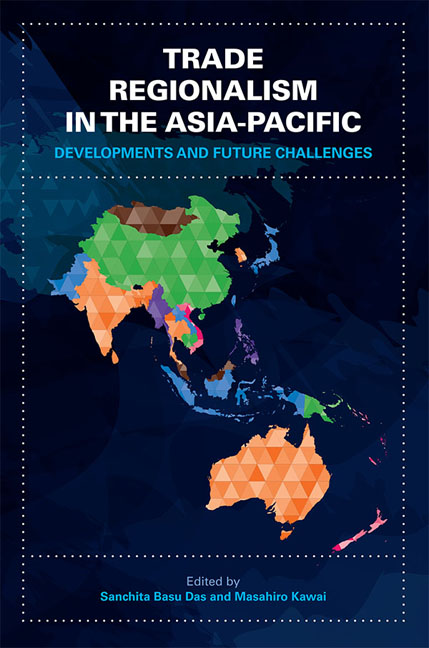Book contents
- Frontmatter
- Contents
- Foreword
- Acknowledgments
- List of Abbreviations
- The Contributors
- 1 Introductory Overview — Trade Regionalism in the Asia-Pacific: Developments and Future Challenges
- I The Trans-Pacific Partnership (TPP) Agreement
- II The Regional Comprehensive Economic Partnership (RCEP) Agreement
- 6 RCEP Prospect and Challenges: Political Economy of East Asian Integration
- 7 Challenges Facing the RCEP Negotiations
- 8 From AEC to RCEP: Implications for the CLMV
- 9 RCEP: An Indian Perspective
- III Regional Economic Integration: A Multi-stage Approach
- IV Old and Emerging Approaches to Asia-Pacific Regional Integration
- V Asia-Pacific Regional Integration: Towards Convergence?
- Index
7 - Challenges Facing the RCEP Negotiations
from II - The Regional Comprehensive Economic Partnership (RCEP) Agreement
Published online by Cambridge University Press: 05 July 2016
- Frontmatter
- Contents
- Foreword
- Acknowledgments
- List of Abbreviations
- The Contributors
- 1 Introductory Overview — Trade Regionalism in the Asia-Pacific: Developments and Future Challenges
- I The Trans-Pacific Partnership (TPP) Agreement
- II The Regional Comprehensive Economic Partnership (RCEP) Agreement
- 6 RCEP Prospect and Challenges: Political Economy of East Asian Integration
- 7 Challenges Facing the RCEP Negotiations
- 8 From AEC to RCEP: Implications for the CLMV
- 9 RCEP: An Indian Perspective
- III Regional Economic Integration: A Multi-stage Approach
- IV Old and Emerging Approaches to Asia-Pacific Regional Integration
- V Asia-Pacific Regional Integration: Towards Convergence?
- Index
Summary
INTRODUCTION
The Association of Southeast Asian Nations (ASEAN) adopted the Regional Comprehensive Economic Partnership (RCEP) framework at the 19th ASEAN summit in Bali in November 2011. The objective of the RCEP agreement is to consolidate ASEAN's respective “+1” Free Trade Agreements (FTAs) with Australia, China, India, Japan, South Korea, and New Zealand into a region-wide free trade arrangement that is consistent with the World Trade Organization (WTO).
The RCEP has embraced seven areas for negotiation: trade in goods, services, and investment; economic and technical cooperation; dispute settlement; intellectual property rights; and competition policy. This is a significant improvement over the existing “ASEAN Plus” FTAs, which have focused on the more traditional tenets of trade liberalization, i.e., increasing market access for goods, services, and investment. Furthermore, its Guiding Principles state that the partnership is open to “including other issues covered by FTAs among RCEP participating countries … in the course of negotiations”, and has an open accession clause to facilitate the participation of external economic partners. The broader economic ends of the RCEP are to widen its members’ participation in regional and global production networks and reduce transaction costs and inefficiencies created by multiple overlapping Asian trade agreements (Basu Das 2013a).
Although the RCEP negotiations were off to a good start since May 2013, it is evident that the negotiation process is going to face several economic and political obstacles. As an economic integration arrangement predominantly among developing countries, the RCEP is the first of its kind and has no predecessor to emulate. It involves three different dynamics, both among and between its sixteen participating members: (i) the ten ASEAN members; (ii) ASEAN and its FTA partners; and (iii) the six FTA partners. The ten members of ASEAN have pledged to work on economic integration since the 1990s and the ASEAN member countries have been working with their FTA partners since 2000. However, the six FTA partners do not all have existing comprehensive trade agreements with one another (see Table 7.1).
Moreover, political factors such as historical conflicts and unsettled territorial disputes will continue to underline the difficulties of negotiations among, for example, the three North-eastern states. In addition, although India has been viewed as a rising economic power, its position in multiparty trade negotiations remains rather conservative. It has been branded a hardliner with a “defensive strategy” (Ramdasi 2010).
- Type
- Chapter
- Information
- Trade Regionalism in the Asia-PacificDevelopments and Future Challenges, pp. 122 - 146Publisher: ISEAS–Yusof Ishak InstitutePrint publication year: 2016

